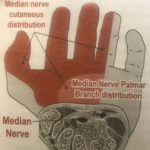Carpal instability is due to disruption of the ligamentous support of the carpal bones and radius. Because carpals belong to one of the most complicated regions of musculoskeletal anatomy, diagnosis, and treatment is very fine-tuned. As a result, many patients with carpal instability seek out osteopaths.
What causes carpal instability?
All joints in the body are supported by ligaments. When ligaments in the wrist and hand are compromised, e.g. due to overuse (repetitive strain injuries), impact injuries such as a fall on the outstretched hand (FOOSH) or general hypermobility (e.g. Ehlers-Danlos or Marfan syndrome), carpals instability is the result.
Degenerative problems can also cause carpal instability because the congruency between bones can be lost. This is when joint surfaces do not fit together well because the articulating surfaces have deteriorated. The main cause for joint degeneration is rheumatoid arthritis and osteoarthritis.
In the case of instability of the carpal bones, ligamentous laxity is a more common underlying factor than joint degeneration.
Who gets carpal instability?
Carpal instability is especially common in athletes or labourers that rely heavily on their wrists, most notably rugby players and massage therapists.
If you have rheumatoid arthritis, it is a good idea to seek out a practitioner, such as a herbalist, for your pain before the condition leads to instability.
What are the symptoms?
The main symptom is wrist pain. Sometimes, there is crepitus or clicking on movement.
Carpal instability can cause other conditions, such as carpal tunnel syndrome, tendinopathy, or osteoarthritis. If you notice tingling or numbness in the hand, chances are the carpal instability has led to carpal tunnel syndrome.
How is it diagnosed?
The best diagnosis is through palpation. In order to rule out other pathologies, it may be necessary to perform an x-ray.
What are the treatments for carpal instability?
If the injury is acute, for example after a fall, you should avoid aggravating movement. Where possible, rest the wrist and hand. If you have strapping tape or a splint, you can immobilise and compress the wrist. Ice can help reduce any local inflammation. Later, you can use heat therapy.
Massage
Massage of forearm muscles can be helpful. But massage directly over the carpal bones should be avoided.
Acupuncture
An acupuncturist will work with the local wrist points PC6, LI4, and LI11.
Surgery
Surgery is only indicated in severe and chronic cases. There are many methods, e.g. bone grafts.
Can osteopathy help carpal instability?
As an osteopath, I focus on joint dysfunctions and the muscles that support the wrist. I use AK muscle testing to ascertain subtle dysfunctions and correct these with manipulations. Subtle ‘repositioning’ through osteopathic manipulation takes the strain off ligaments. And treating restrictions in hypomobile joints can take the onus of movement off the hypermobile joints.
I have found carpal instability to respond well to osteopathic treatment.
If you have carpal instability, don’t hesitate to get in touch.
To book an Osteopathy appointment in New Malden or in Marylebone, phone 020 8942 3148 or contact Aston Clinic London.
Aston Clinic London is a third-generation complementary health clinic based in New Malden and serves the local areas of Kingston, Wimbledon, Raynes Park, Surbiton, Chessington, Worcester Park, Sutton and other areas of southwest London and Surrey.
Aston Clinic London also offers Osteopathy and Herbal Medicine in Marylebone, Central London.

